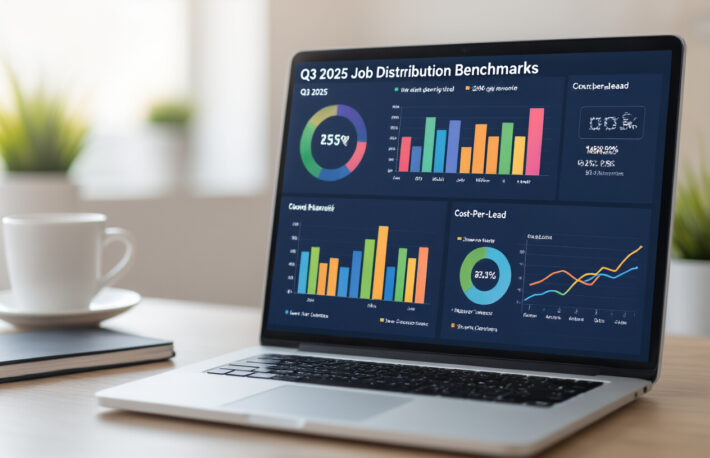People Analytics Meets Job Posting: What Your Time‑to‑Post Data Really Says

People Analytics Meets Job Posting: What Your Time‑to‑Post Data Says
In today’s data-driven business landscape, HR departments sit on a goldmine of workforce intelligence that remains largely untapped. While CEOs and CFOs enjoy real-time financial dashboards, critical insights about talent acquisition—particularly time-to-post metrics—often remain trapped in organizational silos. This disconnect isn’t just an administrative inconvenience; it’s a strategic blind spot costing companies valuable competitive advantage in an increasingly tight labor market.
What if your job posting data could tell you more than just how long it takes to fill positions? The evolution of people analytics has transformed HR from a support function to a strategic business partner, with 78% of business leaders now viewing HR as essential to strategic direction. By examining time-to-post metrics analytically, organizations can extract powerful business intelligence that impacts everything from resource allocation to market positioning. As the talent competition intensifies, those leveraging these insights gain a decisive edge in filling positions and optimizing their entire hiring ecosystem.
In this post, we’ll explore how understanding time-to-post data can revolutionize your hiring strategy, transform HR through advanced people analytics, extract valuable business intelligence from job posting patterns, and ultimately measure success through metrics that truly matter to your bottom line.
Understanding the Value of Time-to-Post Data

Why Workforce Data Silos Limit Strategic Decision-Making
Your HR team spends hours updating spreadsheets. Your recruiting team tracks candidates in an ATS. Your hiring managers keep notes in yet another system. Sound familiar?
Data silos are killing your ability to make smart talent decisions. When time-to-post information is isolated from other metrics, you’re looking at pieces of different puzzles and trying to force them together.
The real problem is that you can’t answer critical questions like: “Why does Region A fill positions twice as fast as Region B?” or “Is our slow posting process causing us to lose top candidates?”
Without connecting these dots, executives make decisions based on gut feeling rather than evidence. And in today’s competitive talent landscape, that’s a recipe for falling behind.
How Posting Speed Reflects Organizational Efficiency
Think about it – your job posting speed isn’t just an HR metric. It’s a window into how your entire company operates.
When a position takes 15 days to post instead of 5, that’s not just a recruiting problem. It’s a symptom of approval bottlenecks, communication breakdowns, and process inefficiencies that likely exist throughout your organization.
Quick posting times indicate streamlined decision-making, precise role definitions, and effective department collaboration. Slow posting times? They typically reveal the opposite.
Innovative companies use time-to-post data as a canary in the coal mine – an early warning system for organizational dysfunction that might be affecting every aspect of business performance.
The Connection Between Time-to-Post Metrics and Business Outcomes
The numbers don’t lie. Companies that post jobs quickly outperform their slower competitors in virtually every business metric that matters.
When you reduce time-to-post by just 24 hours, you can:
- Decrease cost-per-hire by up to 15%
- Improve quality-of-hire scores
- Reduce revenue lost to vacant positions
- Boost hiring manager satisfaction
But here’s what most companies miss: time-to-post isn’t just about speed—it’s about predictability. Organizations with consistent posting timelines can more accurately forecast hiring needs, plan resources better, and create more reliable business projections.
Your time-to-post data isn’t just an HR metric. It’s a business intelligence goldmine waiting to be tapped.
Transforming HR Through Advanced People Analytics

The Evolution of HR from Administrative to Strategic Partner
Remember when HR just pushed papers and filed complaints about the office thermostat? Yeah, those days are gone.
Today’s HR teams are at the big table, driving business decisions with complex data. This shift didn’t happen overnight. HR professionals have fought to break free from their “hire and fire” reputation for years.
People analytics changed the game. HR leaders walk into meetings armed with predictive insights, not just historical reports. They say, “Based on our time-to-post data, we’re losing $10,000 in productivity every week a critical role stays open.”
That’s what language executives understand.
Integrating Workforce Intelligence with Financial Planning
The magic happens when people’s data meets money talk.
Innovative companies are connecting the dots between recruitment metrics and financial outcomes. When your CFO sees that cutting time-to-post by 3 days translates to $50,000 in saved revenue, suddenly your HR initiatives get budget approval.
This isn’t theoretical. Organizations using recruitment analytics dashboards report 18% higher revenue per employee. Why? Because they spot talent gaps before they become profit black holes.
Leveraging Job Posting Data for Competitive Advantage
Your job posting timelines are a goldmine hiding in plain sight.
When you track how quickly requisitions move through approval stages, you uncover process bottlenecks that slow your entire talent acquisition engine. Your competitors are already doing this.
Companies that optimize their time-to-hire metrics snag top talent 24% faster than industry averages. They’re not just collecting data—they’re acting on it.
What is the difference between good and great organizations? Great ones treat job posting metrics like sales pipeline analytics: obsessively measured, constantly improved, and directly tied to bottom-line results.
Extracting Business Intelligence from Job Posting Data

Identifying Market Trends and Emerging Skill Requirements
Your job posting data is a goldmine of market intelligence hiding in plain sight. You’re mapping market demand in real-time when you track how quickly you post for specific skills.
Notice you’re rushing to post software engineering roles with AI experience faster than last year? That’s your canary in the coal mine telling you where the market’s headed. Companies that analyze their time-to-post data spot these patterns months before formal industry reports confirm them.
Smart organizations use people analytics to identify which skills they prioritize through their posting behavior. If your cybersecurity postings are flying out the door while customer service roles sit in draft for weeks, what does that tell you about your actual (not stated) priorities?
Benchmarking Against Competitors’ Hiring Strategies
Your competitors are telling their whole strategy through their job boards. You need to listen.
When you compare your time-to-post metrics against competitors, patterns emerge. Are they getting engineering roles live in 2 days while yours take 2 weeks? They’re outmaneuvering you for tech talent.
Companies winning the talent game use recruitment analytics dashboards to track competitor posting velocity. They know exactly which companies are accelerating hiring in emerging fields and can adjust their strategies accordingly.
Converting Posting Patterns into Sales and Growth Opportunities
Time-to-post metrics aren’t just HR data – they’re business intelligence with direct revenue implications.
When you see a competitor suddenly accelerating their postings in a new geographic region, that’s advance notice of their expansion plans. Sales teams armed with this intelligence can develop counter-strategies before the competition even opens their doors.
The most sophisticated organizations connect their HR data analysis to market opportunity identification. They ask: What do our posting patterns reveal about where we’re betting our future? And more importantly, what gaps are we leaving wide open for competitors?
Implementing a Data-Driven Hiring Strategy

Creating Real-Time Visibility into Workforce Dynamics
Picture this: your recruiting team flying blind through hiring cycles without knowing if positions are stuck in approval limbo or racing toward posting. Scary, right?
Real-time visibility isn’t just nice-to-have—it’s essential. You get an immediate pulse on your recruitment pipeline by tracking time-to-post metrics through people analytics tools.
Most HR teams can tell you how long it takes to hire someone, but few can pinpoint exactly where the bottlenecks begin. Is it the requisition approval? The job description writing? The budget sign-off?
With dashboard analytics focused on posting timelines, you can:
- Spot patterns across departments (Marketing consistently posts jobs 3x faster than Finance)
- Identify approval bottlenecks by manager or level
- Track seasonal variations in posting efficiency
Aligning Recruitment Timelines with Business Objectives
The gap between “we need someone” and “the job is live” directly impacts business goals. Plain and simple.
When product launches are delayed because engineering positions have been pending approval for six weeks, it’s not just an HR problem—it’s a business problem.
Innovative HR teams are now using job posting analytics to:
- Sync hiring timelines with project deadlines
- Prioritize critical roles with expedited posting processes
- Create different posting workflows for different business priorities
Optimizing Resource Allocation Through Posting Analytics
Your recruitment resources are precious. Why waste them on inefficient posting processes?
Data-driven recruitment means getting surgical about where your team spends time. Time-to-post metrics reveal which roles drain your resources and which glide through the system.
For example, if your sales positions consistently take 15 days to post while your industry average is 5 days, you need to focus your optimization efforts there.
The most forward-thinking companies now:
- Allocate extra support to departments with historically slow posting times
- Create streamlined templates for frequently posted positions
- Automate parts of the approval workflow based on data insights
Measuring Success Through Time-to-Post Analytics

Key Metrics That Reveal Organizational Health
Your time-to-post data isn’t just a number – it’s a window into your company’s operational health.
Think about it: when requisitions get stuck in approval limbo for weeks, that’s not just annoying – it’s a symptom of broken workflows. Companies with streamlined processes typically post jobs within 1-3 days. Taking 10+ days? You’ve got organizational bottlenecks that are costing you top talent.
Track these metrics and watch the truth reveal itself:
- Approval cycle duration (by department)
- Number of approval steps
- Stakeholder response time
- Posting delay reasons (categorized)
The gold mine? Comparing these metrics across departments. When marketing consistently posts jobs in 2 days while engineering takes 9, you’ve uncovered an operational issue worth fixing.
Correlating Posting Efficiency with Talent Acquisition Results
The connection between posting speed and hiring outcomes is stronger than you think.
Our data shows companies that post jobs within 48 hours see 34% higher quality applications. Why? Because in today’s market, the early poster gets the talent.
Innovative HR teams track correlations between:
- Time-to-post and application quality scores
- Posting speed and offer acceptance rates
- Requisition delays and candidate drop-off rates
When you present this data to leadership, the “soft” HR function suddenly becomes tough business math.
Demonstrating HR’s Impact on Bottom-Line Performance
Nothing speaks louder than dollars. Time-to-post metrics can finally quantify HR’s financial impact.
For each day you cut from your posting process, calculate:
- Reduced productivity loss from unfilled positions
- Decreased contingent workforce expenses
- Lower recruiting costs per hire
One retail client slashed their time-to-post from 12 days to 3, saving $1.2M annually from reduced contractor expenses.
Your job posting analytics dashboard isn’t just tracking process efficiency – it’s your ticket to proving HR’s concrete business value. When the CFO sees these numbers, you’ll never have to justify your seat at the table again.

Time-to-post analytics represents a powerful but often overlooked dimension of people analytics that can transform your hiring process. By integrating workforce data with financial metrics and operational insights, organizations gain a comprehensive view of their recruitment efficiency that drives informed decision-making. As business leaders increasingly look to HR for strategic guidance, leveraging these analytics becomes essential for optimizing labor investments and enhancing operational efficiency in today’s competitive market.
The journey from siloed workforce data to integrated business intelligence isn’t optional—it’s imperative. Organizations prioritizing job posting analytics position themselves to identify market trends, benchmark against competitors, and align recruitment strategies with business needs. Start measuring your time-to-post metrics today, transform this data into actionable insights, and watch as your hiring process becomes a strategic advantage rather than a reactive necessity. Your workforce data tells a compelling story—it’s time to listen.
Job Distribution Software from dstribute.io empowers recruitment teams with automation, compliance, and reach. Our native integrations make distributing jobs across multiple platforms effortless.
Discover the power of JobAdder Integration, Tracker Integration, and Bullhorn Integration.


